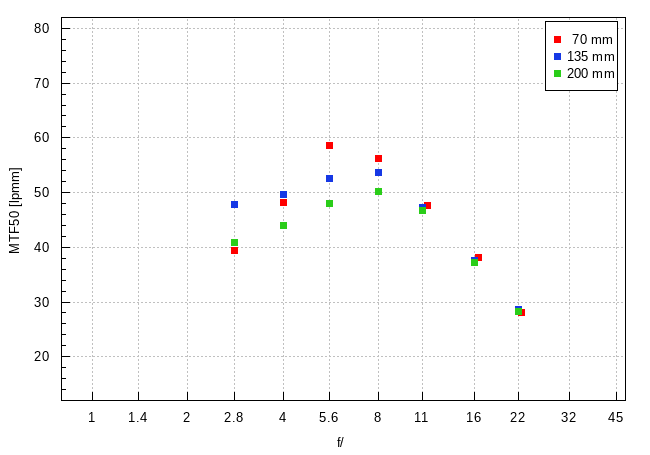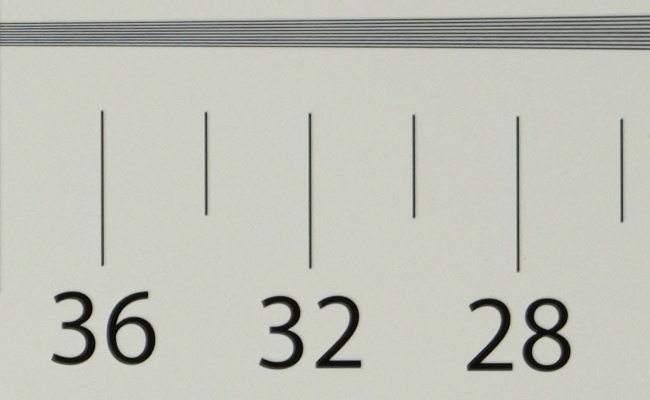Sigma S 70-200 mm f/2.8 DG DN OS
4. Image resolution
Let's see how the Sigma S 70-200 mm f/2.8 DG DN OS compares – its results in the frame centre at 70, 135, and 200 mm presents graph below.

When it comes to the results in the frame centre several things stick out. First, it is obvious the lens's performance has been optimized for the middle of the focal range – it fares the best at that point exactly. Second, the Sigma is able to generate sharp images up from the maximum relative aperture, no matter what focal length you employ. Third, on stopping down the aperture by 1-2 EV image quality improves so much that the lens can get to a level of about 70 lpmm, a very good result for a zoom lens.
Please Support UsIf you enjoy our reviews and articles, and you want us to continue our work please, support our website by donating through PayPal. The funds are going to be used for paying our editorial team, renting servers, and equipping our testing studio; only that way we will be able to continue providing you interesting content for free. |
- - - - - - - - - - - - - - - - - - - - - - - - - - - - - - - - - - - - - - - - - - - - - - - -
Still, you have to mention the fact that there is a regress when you compare the new Sigma to the much heavier reflex camera model which also had a more complex optical design. Its differences between the maximum relative aperture and apertures ranging from f/4.0 to 5.6 were much lower. You can say the new lens's performance steps back to the results of the Sigma 70-200 mm f/2.8 EX DG APO OS HSM, launched in 2010.
What's more, in this category the Sigma loses the duel with its direct rivals. The much more expensive Sony could reach near 80 lpmm and at the maximum relative aperture it hovered around 70 lpmm. The Tamron fared distinctly beter at 70 mm because it was optimized to do so. The differences at longer focal lengths are slight and in real life photos practically imperceptible but if you take a closer look at these results, the Tamron prevails once again, especially near the maximum relative aperture.
Let's check the performance of the tested lens on the edge of the APS-C sensor.

In this case differences between particular focal lengths fade out a bit. The best results you get at the 135 mm focal length and, once again, the performance is beyond reproach. All focal lengths are sharp up from the maximum relative aperture and on stopping down the aperture they are able to get to a good level from about 55 to over 60 lpmm. Unfortunately once again the Sigma loses its duel with two direct rivals.
At the end of this chapter let's deal with the performance on the edge of full frame.

By and large you can repeat what it's been already said. Once again the 135 mm focal length fares a tad better than both ends of the range. At the same time you are able to get decent images in all cases, even at the maximum relative aperture. On stopping down, for a change, you get to a good level of 50-60 lpmm. Once again the results of the Sony and the Tamron are a bit better than that.
To sum up you can say the task of the Sigma S 70-200 mm f/2.8 DG DN OS was rather difficult here. Firstly, its weight is seriously reduced and its optical system – not as complex as in previous versions. It simply couldn't match excellent results of its reflex camera predecessor. Secondly, competition with the more expensive Sony was not an easy thing either – after all the Sony costs almost $2800, almost twice more than the Sigma. Thirdly, the Tamron 70-180 mm f/2.8 Di III VC VXD G2 costs about $200 less than the Sigma, took a shortcut and offered a narrower focal length range and a construction that changes its dimensions. With the same optics complexity it is much easier for such a construction to achieve a bit higher resolution values. Still, you should add that in its case you save on weight as well because the Tamron is almost half a kilo lighter than the Sigma.
At the end of this chapter, traditionally, we present crops taken from photos of our resolution chart; they were taken from JPEG files saved along RAW files we used for the analysis above.
| A7R IIIa, JPEG, 70 mm, f/2.8 |
 |
| A7R IIIa, JPEG, 135 mm, f/4.0 |
 |






